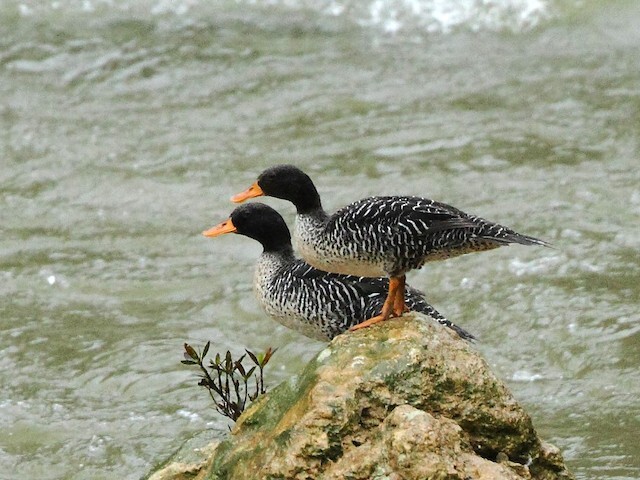Salvadori’s Teal

Scientific Name
Salvadorina waigiuensis
Alternative Names
Salvadori’s Duck, Salvadori’s Teal
Measurements
| Feature | Male | Female |
|---|---|---|
| Length | 38–43 cm (15–17 in) | 38–43 cm (15–17 in) |
| Wingspan | 56–71 cm (22–28 in) | 56–71 cm (22–28 in) |
| Weight | Slightly above 342 g (12 oz) | Around 342 g (12 oz) |
Status
Salvadori’s Teal is native to New Guinea and lives in fast-moving rivers and streams in highland areas. It has a small range and is rarely seen. The IUCN lists it as Least Concern, but the population is believed to be slowly decreasing.
Identification
A small duck with a dark-brown head and neck. Its body is covered in brown and off-white bars and spots. It has a yellow bill and bright orange legs. Males and females look similar, but the male is slightly larger.
Voice
This species is generally quiet. Only soft, low calls are heard, mostly when alarmed or disturbed.
Diet
Omnivorous—eats water plants, insects, larvae, and possibly small fish. It feeds by dabbling and diving in shallow, fast-moving water.
Distribution
Endemic to New Guinea. Found mainly in the central highlands of Papua New Guinea and Indonesian New Guinea. It lives from 500 to 4,000 m (1,600–13,100 ft) above sea level.
Habitat
Prefers clear, fast-flowing mountain rivers, streams, and occasionally still lakes. It stays close to rocky riverbanks and quiet forested water areas.
Breeding
They build their nests near water, often among rocks, riverbanks, or dense vegetation. It lays 2–4 eggs, mostly during the dry season when river levels are lower.
Wintering
This is a resident species and does not migrate. It stays within its river habitats year-round, moving only short distances when water levels change.
Conservation
Although listed as Least Concern, the population is estimated to be between 2,500 and 9,999 mature birds and is slowly declining. Threats include hunting, habitat damage, water pollution from mining, and predation by dogs. Lack of access to remote habitats helps protect some populations naturally.
